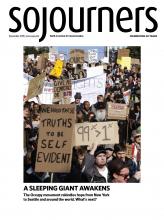“THIS IS THE American Spring,” roared Eric Seligson, 65 and a veteran of Students for a Democratic Society, “and I am a born-again revolutionary!”
The man in charge of the Occupy Wall Street library said he’d been waiting years for this day, and that describes the spirit of many of the older people who came to Zuccotti Park in New York City to volunteer by day and be part of the General Assembly meetings at night.
I was one of them. Together, Seligson and I watched the young people spreading out on their sleeping bags, holding up their signs (“Defend Public Health Not Corporate Wealth”), sweeping the grounds. Together, we silently contemplated the mystery of wonder. Was the awakening of America’s progressive slumber really happening? Or were we both dreaming the way two old men dream, filling our minds with wistful collages of unfinished business?
I was told that the heroes of Tahrir Square twittered their embrace to the youths of Occupy Wall Street who, on Sept.17, made the financial district their unexpected home after staging a protest against Wall Street greed.
I was struck by how many of the protesters, like their counterparts in Tahrir Square, were unemployed students, first-timers at saying no to their country’s power-holders. If nothing else, Occupy Wall Street is a living illustration of one way the First World/Third World dichotomy has narrowed in recent years. Because of the unhappy globalization of joblessness, some in these two worlds are finding themselves on common ground.
Read the Full Article
